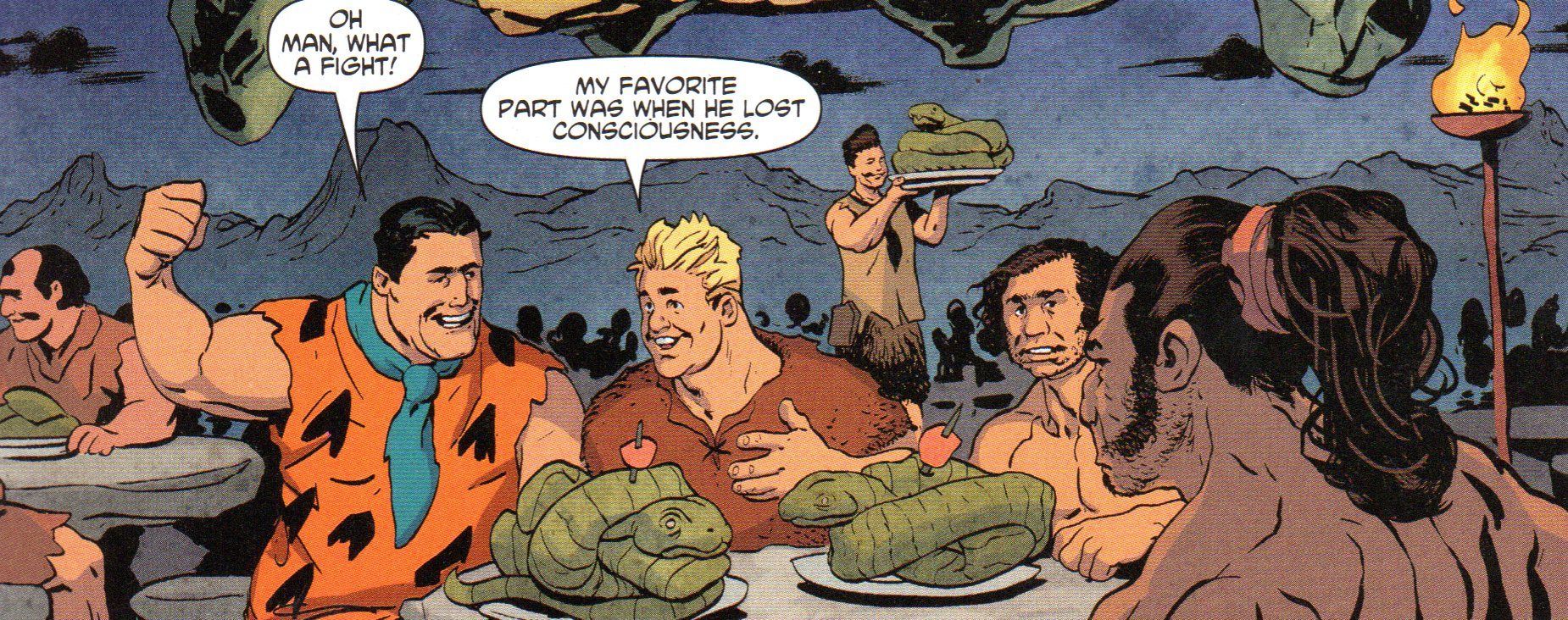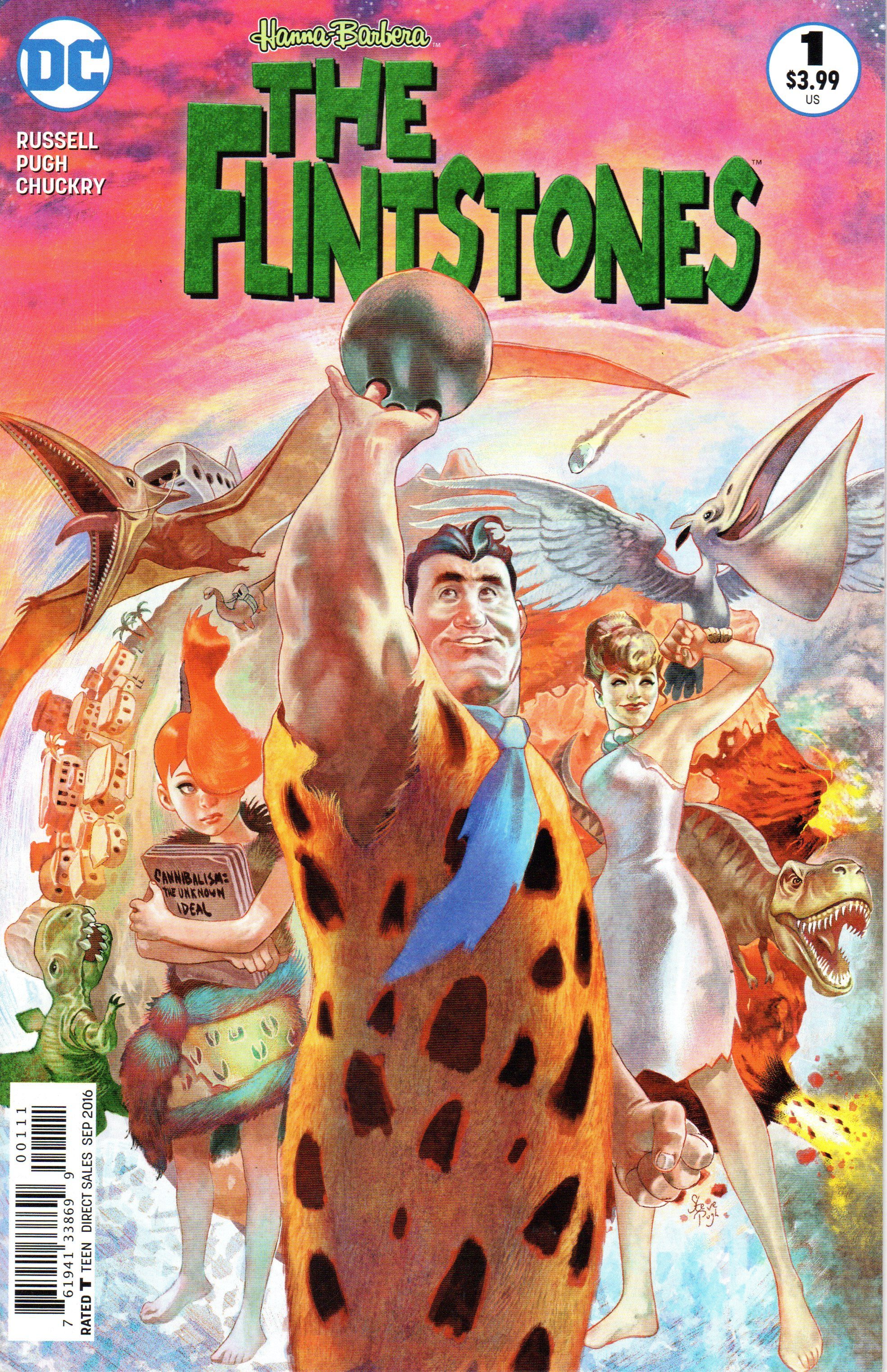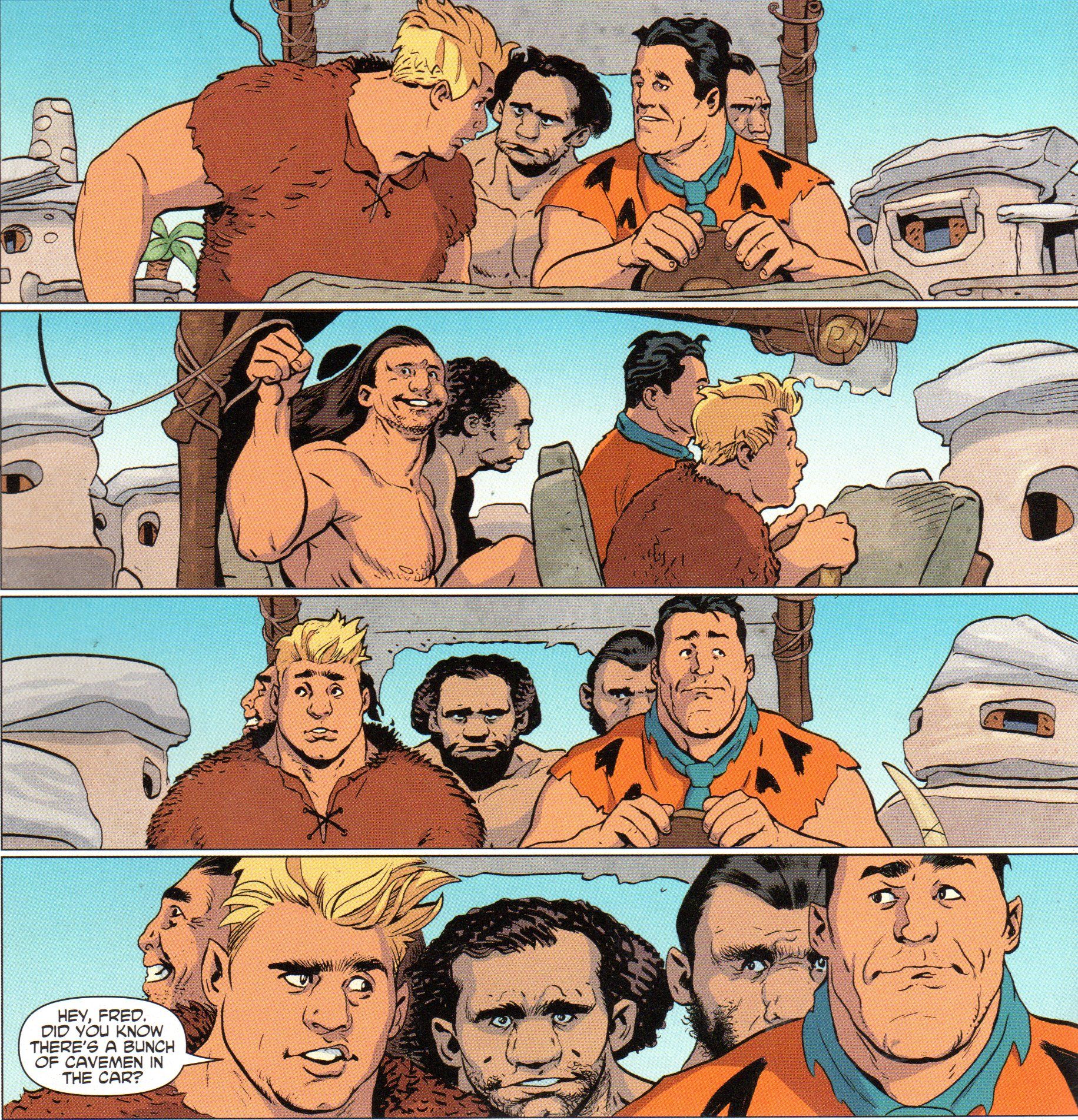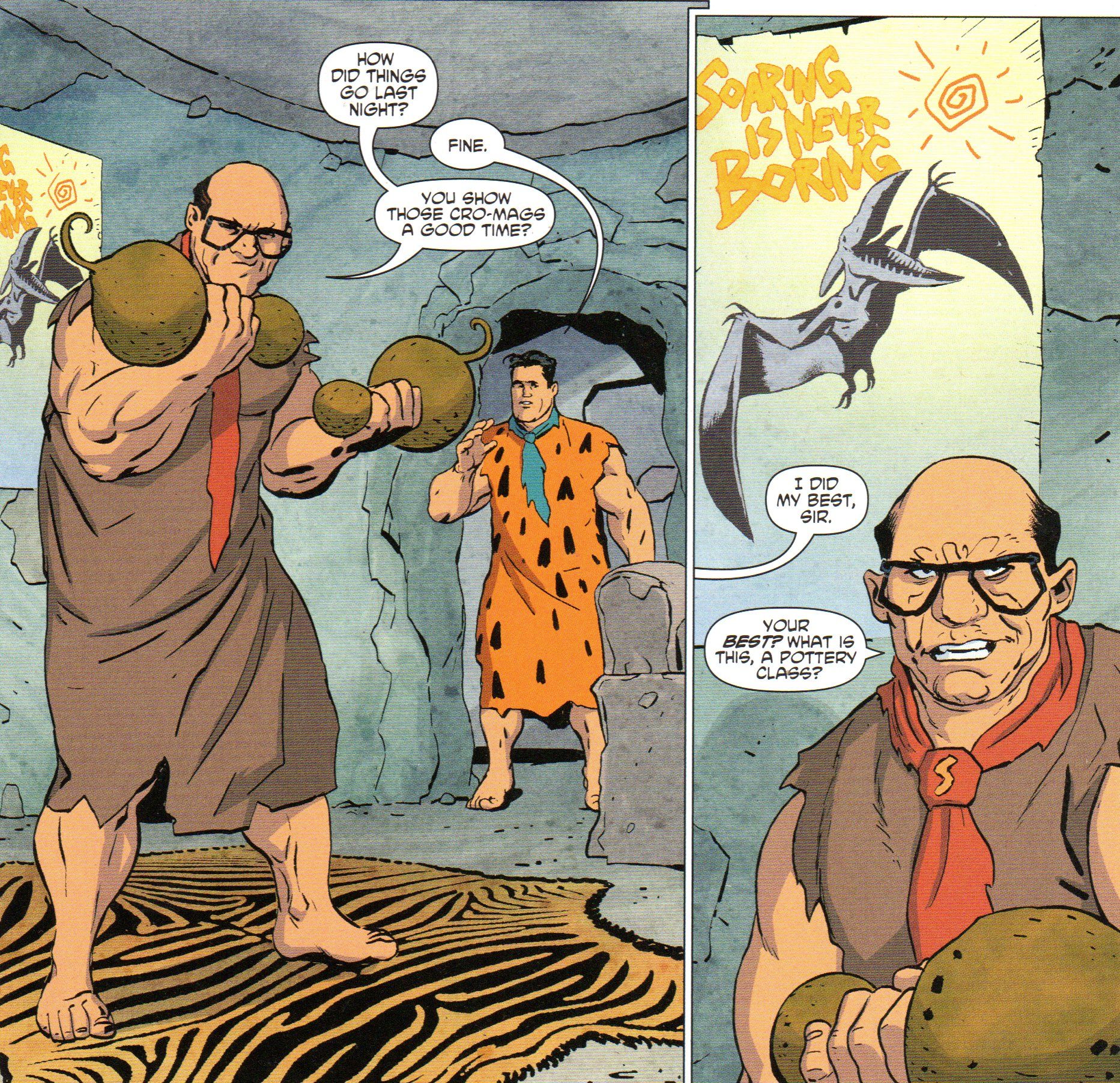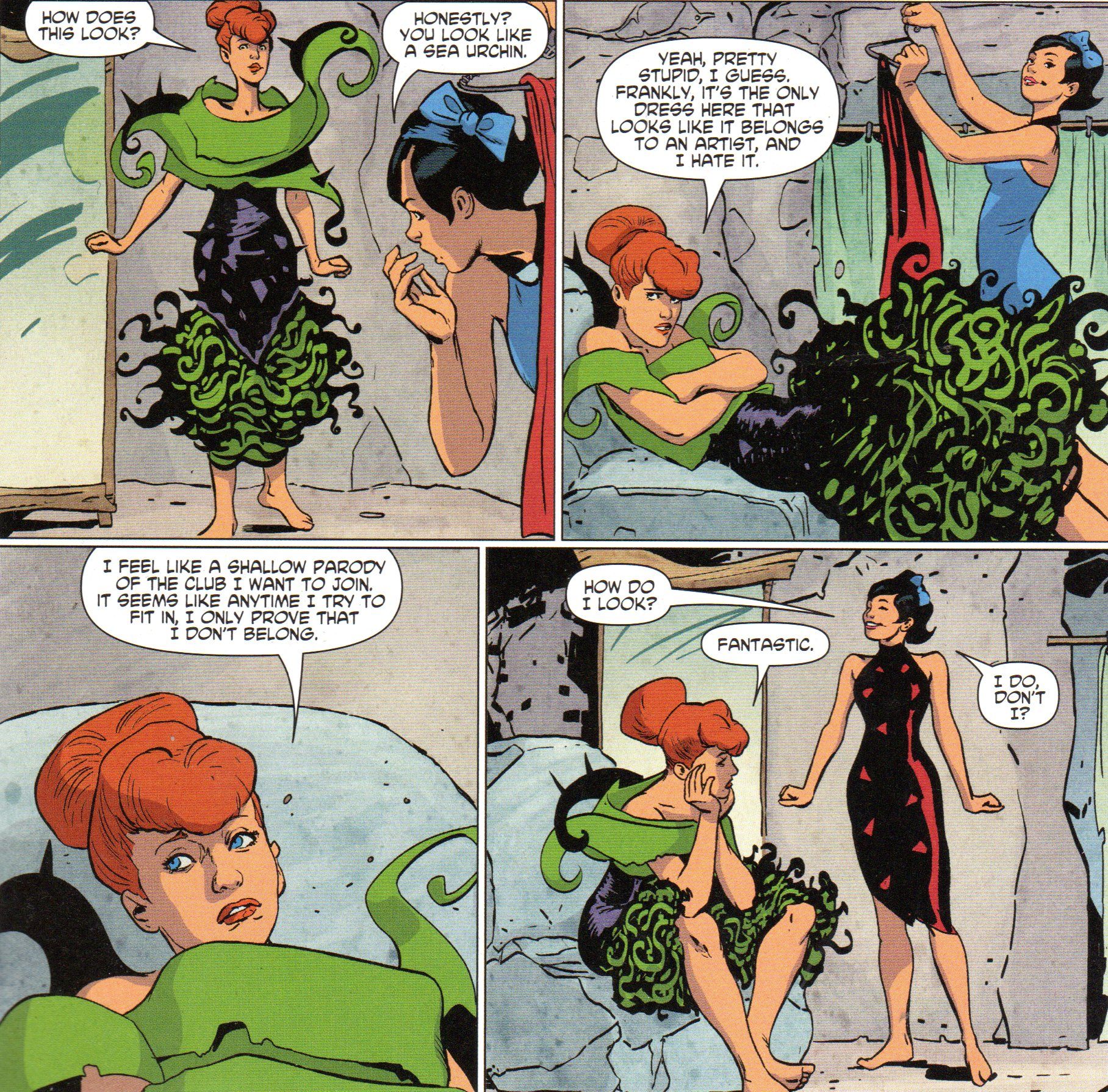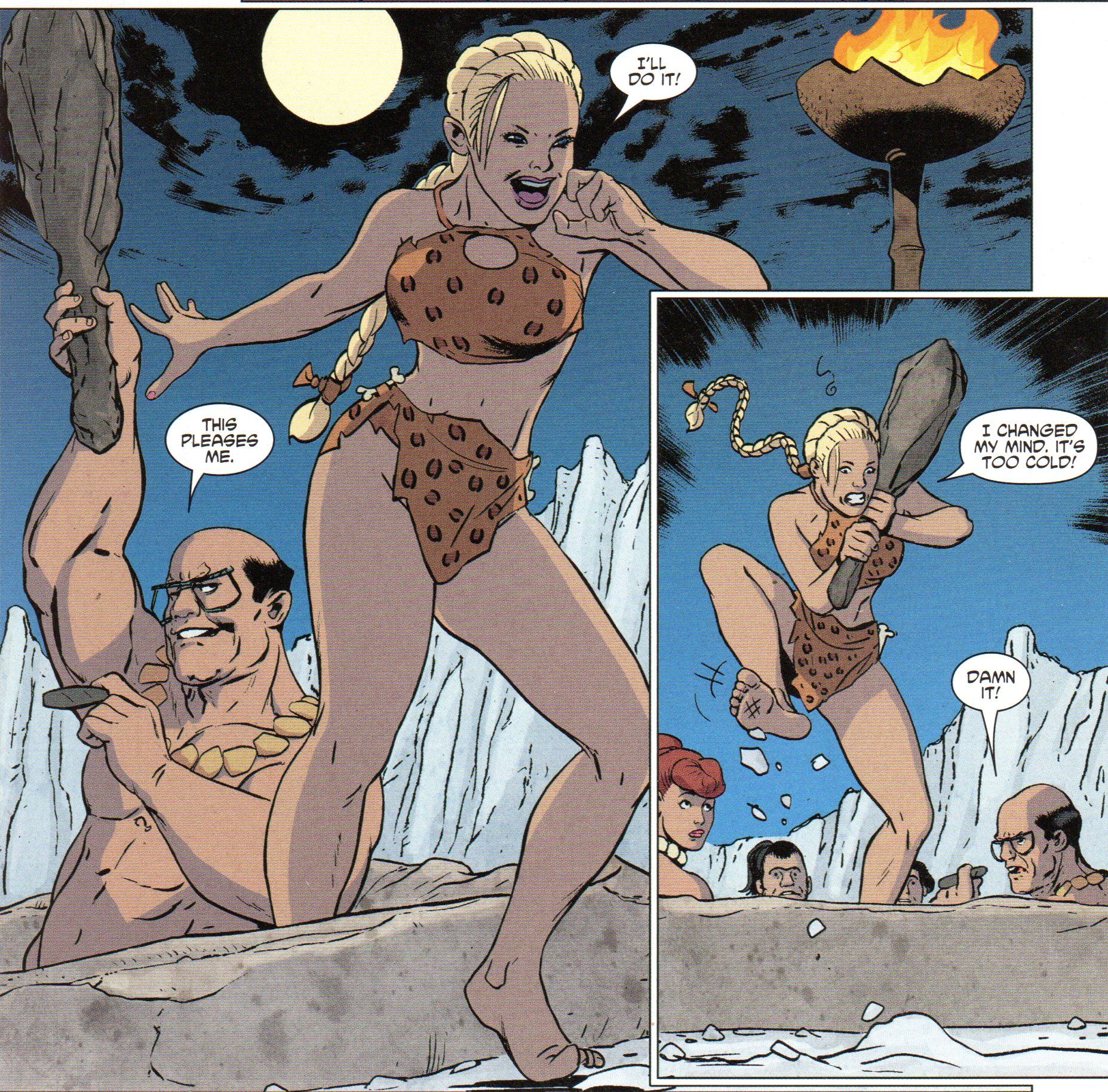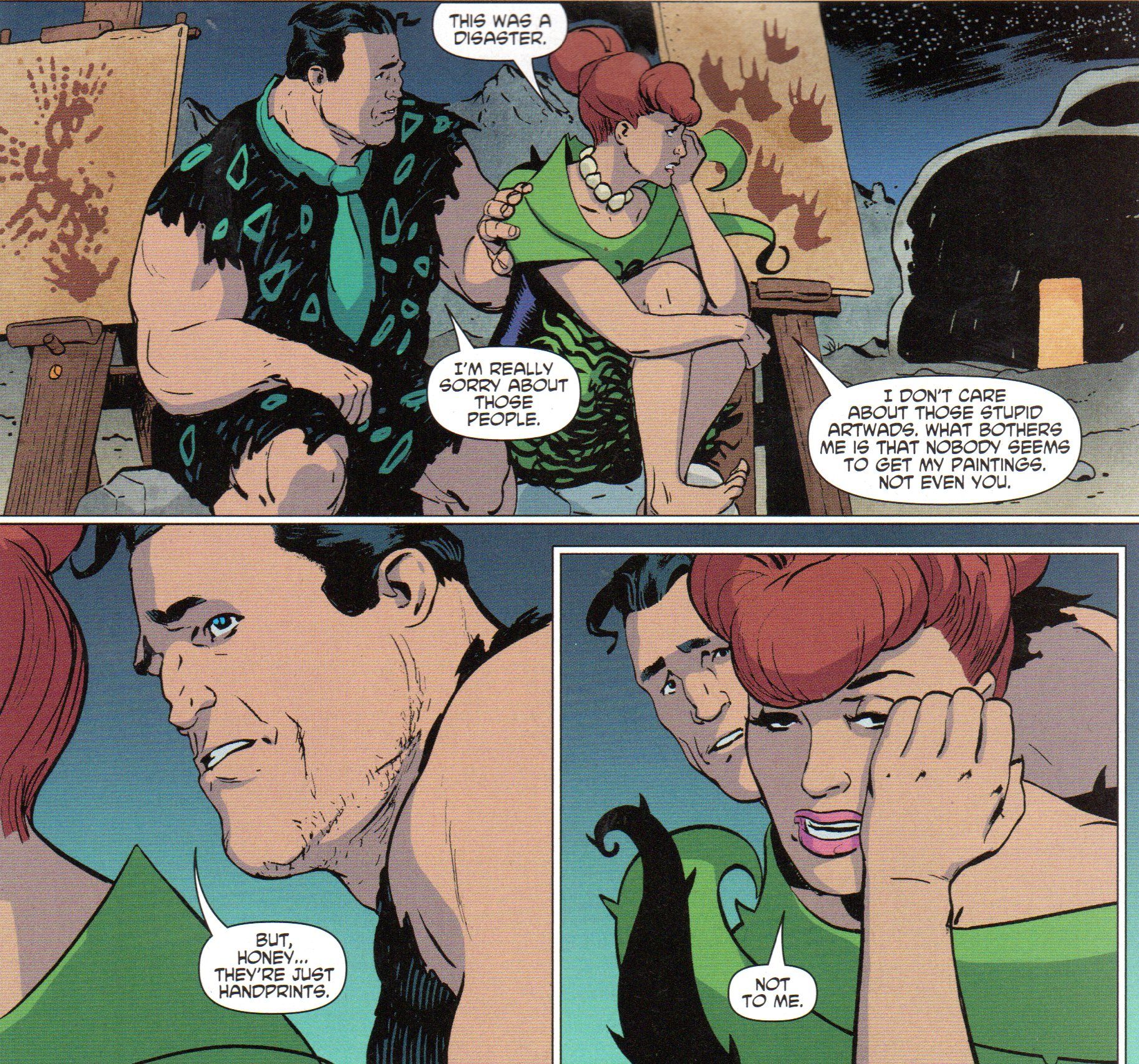The fourth Hanna-Barbera/DC comics collaboration, The Flintstones, came out this week, and like the other three offerings, it's a truly odd comic. I really can't answer my question that forms the title of this post - I want to believe that the people who licensed these characters to DC are just awesome people, but I really wonder if they paid attention to DC when they were told, "Yeah, we're going to mash up a bunch of characters into a Jonny Quest story, put Scooby-Doo and the gang into a post-apocalyptic world, turn Wacky Races into Mad Max, and that's even before we get to the Flintstones!" Maybe they just said, "Yeah, yeah, yeah, who reads comics anyway?" and went back to whatever it is Hanna-Barbera execs do for fun. But hey, we've gotten some interesting comics out of it!
The Flintstones #1 ("A Clean Slate") by Mark Russell (writer), Steve Pugh (artist), Chris Chuckry (colorist), Dave Sharpe (letterer), Brittany Holzherr (assistant editor), and Marie Javins (editor). $3.99, 28 pgs, FC, DC.
I had read a bit about The Flintstones, but I still wasn't prepared for how strange it was. The framing device, after all, takes place in the present and posits that Bedrock and its environs were "real" and that the civilization existed long before any other known civilization. It's only two pages - the first and the last of the issue - but even those two pages are bizarre, as we discover through the course of the book. After the first page, in which the modern-day museum officials (I hope they're docents, just because "docent" is a tremendous word) set up the idea of Bedrock's civilization, we get 26 pages of Fred and his world.
And it's very hard to write about it, because the plot of the comic is more like "several vignettes strung together." But I'll give it a try!
The Flintstones turns out to be a profoundly sad comic. This is evident from the first page, the one set in the present, when we "meet" "Lorenzo" (which is what the docent inexplicably calls him). Steve Pugh, who's drawing this "traditionally" (meaning it doesn't look like Hotwire but does look like his other recent work), does amazing work throughout, beginning with the surprised facial expression he puts on Lorenzo, which seems to indicate, even before we know why he's surprised, a deep-seated sadness. But then we go back 100,000 years to Bedrock, and Russell and Pugh really ramp things up. All the familiar goofiness is here - Pugh gets to draw a double-page spread of Bedrock on Pages 2 and 3 with all the silly puns we loved from the original television show - there's a "Spears and Roebuck" and an "Outback Snakehouse," but even here, we get a "Bird Slavery Emporium," which hints at darker things. The main plot revolves around Fred getting tasked by Mr. Slate to show some new hires around the quarry and around Bedrock at night. The secondary plot deals with Wilma getting selected to exhibit her artwork at a local gallery. Both are quite odd.
Russell uses the cartoony nature of the comic to get into some very serious and troubling topics, and it will be fascinating to see how he deals with them going forward. Slate hires three "Cro-Mags," who quickly correct him that they're Neanderthals, but he ignores them. Slate tells Fred that the new hires are twice as strong as Homo sapiens and have no concept of money, and if Fred can get them to work there (even though he just hired them, I guess they can still back out of the deal?), he'll be the new foreman.
Slate tells the Neanderthals that Fred fought in the "Bedrock Wars" (which might also be the "Paleolithic Wars," as later Fred goes to a meeting at the "Veterans of the Paleolithic Wars" lodge, but let's not split too many hairs) and welcomes them to civilization, which might be awfully tone-deaf of him, as the Bedrock Wars seem to have been fought against Neanderthals themselves. Russell is obviously going for a "colonizer/colonized" dichotomy here, and it permeates the rest of the book. Barney calls them "cavemen," which seems to be a pejorative term, and Slate later implies that the wars were solely for profit (his, to be exact). The meeting at the lodge is rife with men suffering from PTSD, and Pugh gets into the act with an advertisement mocking the "tree people." Slate belittles Fred's manhood at one point, and Russell shows just how "civilized" Bedrock is when Fred and Barney take the Neanderthals to a UFC event (it doesn't quite look like boxing, but maybe it is). When Fred tells one of the Neanderthals that he wears a tie because he read that you should dress for the job you want, not the job you have, it's an unbelievably sad moment because Fred will never be free from Mr. Slate and his condescension. Even when the Neanderthals get paid, Russell turns it into a depressing moment. When Fred and Wilma go to a hot tub party at Slate's mansion (which gives us the only use of Fred's signature phrase, and as with other things in this issue, Russell twists it ironically), we find out why Lorenzo is in the museum at the beginning of the issue, and of course it's not a happy event.
Meanwhile, Wilma's plot also comes to fruition, but not entirely happily (although Russell does re-affirm Fred's love for her, even though he's a clueless meathead quite a lot).
To create her art, she dips her hand in tar and puts prints on canvas, but when her art is actually exhibited, it's a disappointment to her - the "outsider" art is shown literally outside, by the toilets - and to the critics, who sneer that it's too "retro." Even Russell obviously mocking the critics doesn't take the sting out of the pain they inflict, especially because Fred doesn't "get" her art either. It leads to the emotional core of the issue, as Wilma explains to him why she does them the way she does. It's stunning how quickly Russell shifts the tone from bleak existential despair to something that is actually meaningful and deep, as Wilma's story is a far better reason for "civilization" than Mr. Slate's obnoxious belief that it means more money for him. It's wonderfully done, and in a comic this bleak, it's impressive how Russell gets to the humanity of the characters without beating us over the head with it. The Neanderthal's explanation for leaving is a quick but devastating rebuke of Mr. Slate, while Wilma's story is beautiful. It's really well done.
In case you think this is just nothing but despair and darkness, I should assure you that it's not. Part of this is because of Russell's gallows humor, which, while bleak, is often very funny, but it's also because of Pugh's wonderful art and Chuckry's cheery coloring. Pugh is in on the "joke," and as I noted above, it begins with Lorenzo's surprised expression on Page 1.
But the humor of the book comes from the way Pugh realizes the world. There's an art critic kangaroo with a joey shoved inelegantly into its pouch. There's Lorenzo buying a balloon and carrying it everywhere before it finally loses all its air. There's the weird realism of the animals that make the machinery run. There's the odd wedding photo that Wilma looks at (sexual politics comes into this book, too, because why not?). There's the ram that the Neanderthals use as a jackhammer and the way Pugh draws it at the end of the work day. There's the sight gag of Philip the turtle bringing Slate and his guests ice cream. There's Slate's very strange Speedo and his amazing sofa. But Pugh also helps with Russell's themes, as well. He draws Fred with a wonderful faraway gaze quite often, as our hero contemplates what kind of life he's living (which makes his moment with Wilma at the end that much better). He draws the horror of the veterans very well, as well giving us wonderful scared expressions on the faces of the Neanderthals when they hear the war stories, as if they're unsure how to react. He gives us a terrific self-assured Betty Rubble, contrasting her very well with Wilma's existential crisis as she shops for clothes to wear to the exhibition. And the way he softens his line and Chuckry goes with sepia tones when Wilma tells her story is stunning and very effective. This all leads to the final page back in the present, when we "read" Lorenzo differently than we did at the beginning, because we know what happened to him. It's a gorgeous book, and Pugh and Chuckry do a good job capturing both Russell's bleak themes and the oddity of a "modern" Bedrock from 100,000 years ago. It couldn't have been easy to walk that line, but the artists do it well.
Yeah, and Pebbles doesn't show up in this issue, so we can't even discuss that book she's holding on the cover. What the hell is up with this comic?
The Flintstones is really an impressive book.
Unlike Future Quest, which in its first issue (the second one came out this week, but I haven't read it yet) is just a grand balls-to-the-wall adventure (and a pretty awesome one at that), and unlike Scooby Apocalypse, which tries a bit too hard to explain things that don't need explaining (and no, I haven't read that second issue, either), and unlike Wacky Raceland, which is just a concentrated dose of sheer insanity, The Flintstones is exploring uncomfortable topics that rarely get addressed in mainstream comics, and certainly not ones based on old cartoons. Very often, writers use metaphors and allegory to examine societal ills, and that's what Russell is doing here, but it's simply bizarre that he chose to do it in a comic about Fred Flintstone, of all characters. But he does it well.
So those are the four first issues of the Hanna-Barbera/DC collaboration. Scooby Apocalypse was the worst of them, but even that took a simple formula and went a bit nuts with it. My initial question still stands: Is Hanna-Barbera aware of what DC is doing to their properties? If they are, they're a lot cooler than I would expect, because these four issues are the most creative things coming out of DC over the past few months, and it makes me wonder if it's only because they're not actually DC properties. It's too bad DC doesn't let writers and artists go nuts with their own IPs, but we take what we can get, I suppose! So check out The Flintstones - it's really unlike what you think it will be!
Rating: ★ ★ ★ ★ ★ ★ ★ ★ ½ ☆

